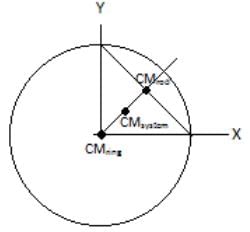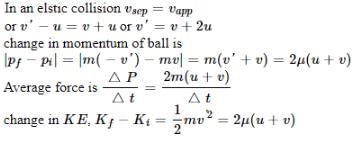Test: Centre of Mass - 2 - JEE MCQ
25 Questions MCQ Test - Test: Centre of Mass - 2
A body has its centre of mass at the origin. The x-coordinates of the particles
An object comprises of a uniform ring of radius R and its uniform chord AB (not necessarily made of the same material) as shown. Which of the following can not be the centre of mass of the object.

In which of the following cases the centre of mass of a an rod is certainly not at its centre ?
Consider following statements
[1] CM of a uniform semicircular disc of radius R = 2R/p from the centre
[2] CM of a uniform semicircular ring of radius R = 4R/3p from the centre
[3] CM of a solid hemisphere of radius R = 4R/3p from the centre
[4] CM of a hemisphere shell of radius R = R/2 from the centre
Which statements are correct?
Two blocks A (5kg) and B(2kg) attached to the ends of a spring constant 1120 N/m are placed on a smooth horizontal plane with the spring undeformed. Simultaneously velocities of 3m/s and 10m/s along the line of the spring in the same direction are imparted to A and B then
Two identical balls are interconnected with a massless and inextensible thread. The system is in gravity free space with the thread just taut. Each ball is imparted a velocity v, one towards the other ball and the other perpendicular to the first, at t = 0. Then,
A ball moving with a velocity v hits a massive wall moving towards the ball with a velocity u. An elastic impact lasts for a time Dt.
A particle moving with kinetic energy = 3 joule makes an elastic head on collision with a stationary particle when has twice its mass during the impact.
Two balls A and B having masses 1 kg and 2 kg, moving with speeds 21 m/s and 4 m/s respectively in opposite direction, collide head on. After collision A moves with a speed of 1 m/s in the same direction, then correct statements is :
The diagram to the right shown the velocity-time graph for two masses R and S that collided elastically. Which of the following statements is true?
(I) R and S moved in the same direction after the collision.
(II) Kinetic energy of the system (R & S) is minimum at t = 2 milli sec.
(III) The mass of R was greater than mass of S.
In a one-dimensional collision between two particles, their relative velocity is before the collision and
after the collision
A set of n-identical cubical blocks lie at rest parallel to each other along a line on a smooth horizontal surface. The separation between the near surfaces of any two adjacent blocks is L. The block at one end is given a speed V towards the next one at time t = 0. All collision are completely inelastic, then
An isolated rail car original moving with speed v0 on a straight, frictionless, level track contains a large amount of sand. A release value on the bottom of the car malfunctions, and sand begins to pour out straight down relative to the rail car.
(a) Is momentum conserved in this process?
(A) The momentum of the rail car along is conserved
(B) The momentum of the rail car + sand remaining within the car is conserved
(C) The momentum of the rail car + all of the sand, both inside and outside the rail car, is conserved
(D) None of the three previous systems have momentum conservation
(b) What happens to the speed of the rail car as the sand pours out?
(A) The car begins to roll faster
(B) The car maintains the same speed
(C) The car begins to slow down
(D) The problem cannot be solved since momentum is not conserved
If the external forces acting on a system have zero resultant, the centre of mass
A particle of mass m moving horizontal with v0 strikes a smooth wedge of mass M, as shown in figure. After collision, the ball starts moving up the inclined face of the wedge and rises to a height h.
The final velocity of the wedge v2 is
When the particle has risen to a height h on the wedge, then choose the correct alternative(s)
Identify the correct statement(s) related to the situation when the particle starts moving downward.
Suppose the particle when reaches the horizontal surfaces, its velocity with respect to ground is v1 and that of wedge is v2. Choose the correct statement (s)
A small ball B of mass m is suspended with light inelastic string of length L from a block A of same mass m which can move on smooth horizontal surface as shown in the figure. The ball is displaced by angle q from equilibrium position & then released.
The displacement of block when ball reaches the equilibrium position is
Maximum velocity of block during subsequent motion of the system after release of ball is
















